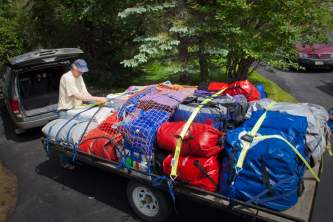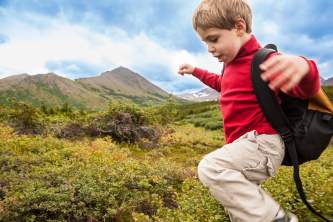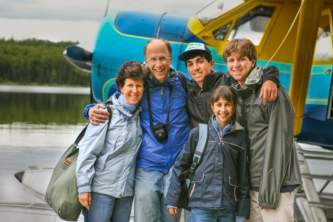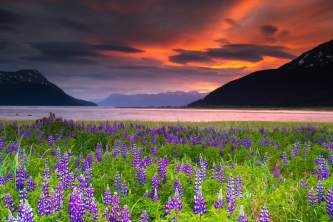Alaska Mosquitoes
No question: mosquitoes can be a pain in the neck. And the arm. And the leg. And just about anywhere we forget to—or don't want to—cover up. Alaska has 35 species of mosquito, and all but a few will be more than happy to nibble on humans. But mosquitoes are only really an issue for Alaska visitors from the second week in June to the last week in July, and even then, they're not nearly as bad as myth would have it.
While the legend is correct that mosquitoes can gather in ferocious swarms (the unofficial record of the most mosquitoes killed in a single swat is 78), the reality is that that kind of mosquito intensity occurs only in rare instances, such as on a perfectly windless evening near a stagnant pond, Interior forest, or moist tundra.
Fortunately, the bug problem is not so bad in most places where Alaska visitors spend time: Anchorage and other cities, parts of the Kenai Peninsula, above treeline and anywhere there's even the slightest breeze (which is most places).
Alaska Mosquito Tips
If you do find yourself in a heavy congregation (mosquitoes seem to be most active at dawn and twilight), there are easy steps you can take to block out the nuisance:
- Wearing loose cut long sleeve shirts and pants creates a physical barrier that keeps bugs away from your skin. Tighter weave cotton shirts and pants work better than more porous synthetics.
- Wear khaki, white, neutral colors, or colors with short wavelengths like blue or green. Mosquitoes are attracted to dark colors with long wavelengths like black, red, and orange.
- Don't use scented soaps, lotions, or shampoos.
- If you're taking a multi-day backpacking or float trip, bring a headnet for backup.
- Use repellent.
Mosquito Repellents for Alaska
For any skin you can't cover up, be sure to apply a mosquito repellent. You have some good options for bug protection in Alaska:
DEET
No question, DEET is the most effective method of combating our pesky neighbors. DEET becomes much more effective as its concentration increases from 0% to 40%. So 30-40% DEET is all you’ll normally ever need. The increase in repellency beyond that is very small. But if you’re backpacking in a heavy bug territory, 95%-100% DEET completely protects you. The bugs will come near, and then fly away—as if an invisible shield protects you.
DEET is a strong chemical. You can sometimes taste it in your mouth from being absorbed through the skin. So only apply it directly on the skin of your face, hair, neck, and hands. For the rest of your body, rub it on your clothes, or use permethrin-treated clothes (see below). And never use 95% or more DEET on small children.
When using DEET:
- Follow the product directions—it WILL melt certain camera cases and jacket fabrics!
- If used with a sunscreen, apply the repellent 30 minutes to one hour after the sunscreen.
- Never use it on wounds or irritated skin (it stings and gets absorbed)
- Wash it off as soon as you're out of mosquito land.
If you're visiting Anchorage, stop into 6th Avenue Outfitters for head nets and bug repellants to help keep the pests away.
DEET Alternatives
Many of us are hesitant to rub harsh chemicals on our skin and prefer natural alternatives. We don’t think they work nearly as well for Alaska mosquitoes as DEET, especially in heavy bug areas, so you're trading off one form of peace of mind for another. But even Alaskan river guides who spend weeks in the wilderness have made the choice to forgo DEET.
The best DEET alternative we’ve found is Picaridin, sometimes referred to as the “DEET of Europe.” This synthetic compound doesn’t have as good of repellent qualities as DEET, but it works pretty darn well—and it doesn’t damage fabrics like DEET, nor have the odor or oily feel, nor have the bad taste when applied to the skin. Brand names include Natrapel 8-Hr Pump Spray, Sawyer Premium, Cutter Advanced, and Repel Smart Spray.
Citronella has long been the best known natural alternative, and scientists are continually finding more herbs to ward off certain insects. Just be sure when looking at these herbal alternatives that they contain at least 10% of the active, insect-repelling ingredient. One of the better ones is Bite Blocker, an oil-based repellent laced with soybean oil, geranium oil, and coconut oil. Or try Avon's Skin-So-Soft Bug Guard, which contains IR3535, an amino acid.
Time-Release DEET
Some people believe time-release repellents containing a minimum of DEET can be as effective against Alaska mosquitoes as full-power DEET, without its harshness. Sawyer Products offers a controlled-release formula. The 20% DEET in it is physically captured inside protein molecules, and as those dissolve on your skin, the DEET is released. And Travel Medicine, Inc's Ultrathon—which is used by the U.S. military—is 33% DEET that's in a controlled-release polymer and should work for 12 hours.
Permethrin-Treated Clothes, Like BuzzOff
Permethrin is an odorless insect repellant formulation that binds to clothing. Many companies now offer insect repellant apparel, based on a formulation approved in 2003 by the U.S. Environmental Protection Agency. Their methods of treating everything from T-shirts to hats and pants keeps insects away (and can last up to 70 launderings) without the need to apply anything directly to your skin. You can find this insect repellent gear at most outdoor recreation retailers. Well-known brands include Ex Officio BuzzOff and Columbia Insect Blocker.
You can also buy the chemical itself and treat your own clothing. One brand is Sawyer Permethrin Pump Spray. It won’t have the same saturation and bonding, but it will still last 2-4 weeks and survive a washing or two—long enough for most Alaska vacations. Note that permethrin is known to be toxic to cats.
Thermacell Devices
If you plan to go fishing, camping, or RV’ing, where you’ll stay in one place for a long time, look into butane-powered Thermacell units that vaporize a repellent into the air. They’re moderately effective in a 10-15 foot zone when there’s no wind.





